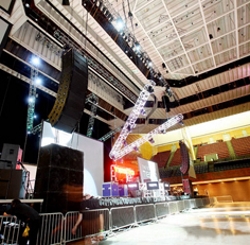
Timbre
The overall timbre, or tonal balance, of a sound system undoubtedly has the strongest influence on the overall perceived quality.This characteristic is easy to measure, both subjectively and objectively, and there is a very good correlation between the two in a small-room configuration. In a large-room sound reinforcement situation, however, this correlation does not hold.
If the system has an overall response that is measurably flat (has nearly the same input-to-output level ratio at all frequencies), it will sound too bright, with the high frequencies being too loud.
A system which sounds subjectively flat, so that the reproduced sound is perceived as being a close duplicate of the source, will have a measured response which rolls down at high frequencies.
Should the analysis be done with a swept filter, which yields more information, or is a stepped filter technique acceptable? What amplitude smoothing or averaging is appropriate? If measurements are taken at single, discrete frequencies, as are commonly done with contemporary techniques, how many measurement points are needed and at what spacing? This could be a major source of misleading data, especially at lower frequencies.
Whatever the technique, how many measurement locations should be taken, and where should they be located? And exactly how should the individual measurements be averaged to yield the overall system response? Also, how much variation between individual measurements is acceptable, and what should be done if the variation exceeds this tolerance?
Schulein documented this discrepancy in 1975 in an elegant experiment and offered a plausible explanation. He noted that in all rooms, the listener receives sound directly from the source and also reflected from the room surfaces.
Here’s the scoop:
Schulein’s Experiment
Two identical loudspeakers are arranged in a room so that the listener receives the direct sound from both, one close and one distant.
The bandpass filter is first set at 1000 Hz and the attenuator adjusted so that the sound level appears to be the same when the noise is switched from one loudspeaker to the other.
Then the filter is changed to another band and the corresponding band on the equalizer is adjusted until the apparent loudness is the same from each loudspeaker.
This is continued through all bands, and repeated as necessary until no further adjustments are necessary.
Finally, the overall frequency response of the equalizer is measured, this being the correction necessary to make the distant loudspeaker sound like the near one in this room.
In a small room, the level of the direct sound is almost always higher than that of the reflected sound and, therefore, dominates in the perception process.
Because of directional characteristics of human hearing at high frequencies, largely due to head shadowing effects, less total sound energy enters the ears at high frequencies than at lower. This imbalance is perceived as normal.
In a large room with typical acoustics, however, the opposite is true; the level of the reflected, or reverberant, sound is significantly higher than that of the direct at most listener locations. Since this reverberant sound arrives at the listener from all directions rather than just one, more of it enters the ears at high frequencies. Thus the highs are perceived as being louder.
A simple experiment tends to confirm this theory. A loudspeaker is located at head level in a relatively non-reverberant environment and fed with broadband noise. A listener stands one to two meters (about three to six feet) in front of the loudspeaker and slowly turns around while listening to the tonal character of the noise. Typically, the overall tonal balance will change little, if at all, with head direction.
However, if two identical loudspeakers are placed two or three meters apart facing each other and both are fed the same broadband noise, a listener between them, turning around as before, will hear the high frequencies more loudly when his ears are toward the loudspeakers than when he is facing one or the other loudspeaker.
The measured response (and perceived timbre) of a loudspeaker in a room deviates significantly from its performance in an anechoic environment, in ways that are complex and quite difficult to predict.
